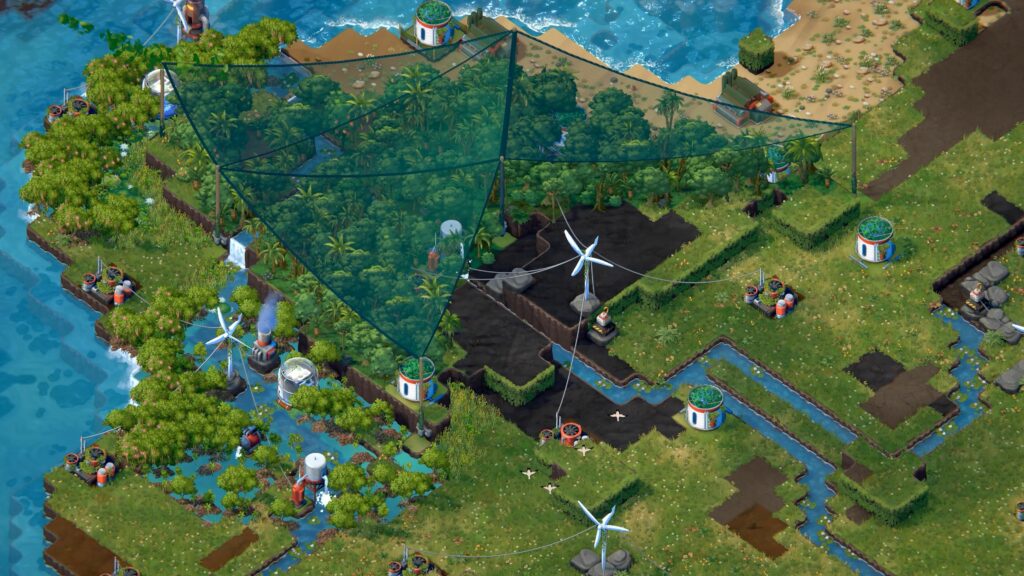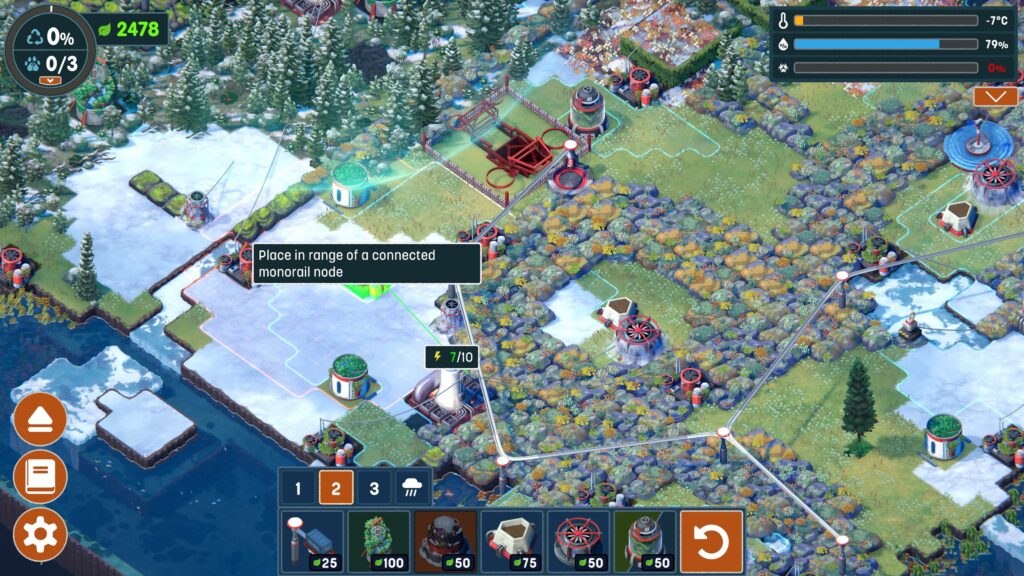Developed by a team based out of South African called Free Lives, Terra Nil begins nonchalantly enough. You start off with a random map generation of its first area, a temperate zone, which you must bring back to life from its desolate starting point by using the basic tools of turbines to provide power to your other structures, toxin scrubbers to purify the wasteland like soil, irrigators to turn the purified soil green with life and water pumps to get rivers flowing again. These are the starting points of most of the challenges you’ll face in getting the unique environmental needs of each region up to snuff again.
Once you have your desolate wasteland looking like green acres, the challenge increases. You’ll next need to get wetlands going by upgrading your irrigators with a hydroponium, which will create swampy, puddle laden biomes that will become the envy of frogs everywhere, but there’s a catch. You can only upgrade irrigators that are on flat grassland in an area that has a relatively high natural concentration of moisture nearby, aka soggy grass close to water.

There’s also catches for each new biome that you introduce into the environment as well, such as beehives being used to facilitate turning your surrounding grassland into a sea of vibrant flowers, however, you may only introduce hives into certain trees that may or may not pop up on your carefully sculpted greenery. Time to plop down some patented Acme Cloud Seeders (patent pending!). They’ll make it rain faster than LeBron James with two minutes left in the fourth quarter against the Boston Celtics.
And you’ll want rain, not only because you’ll need more trees for maximum fynbos facilitation for fastidious flora and fauna fertilization (try saying that three times fast) but also because rain alters the climate and in the early stages of the game, more rain leads to lots of beneficial effects for your burgeoning biomes, such as increased wildflower propagation and salmon appearing in your streams.
The third basic biome is the forest, and you’ll need a large amount of forested areas in your lovingly crafted environment. But there’s a catch. You can only build an arboretum, which spawns an instant forest, on ashy soil. Getting a nice supply of ashy land requires a solar collector, which can laser focus sunlight to a point you designate on the map, turning your lush greenery back to a post apocalyptic state, now with 100% more ash! Just watch where you point that sunlight since you can easily set a large portion of your map aflame if you aren’t careful.

It’s the delicate balancing act between trying to get all three of these basic biomes living in harmony with each other, plus a little rain for flavor, that will make up much of your early game experience. Once you’ve gotten a good mix of all three in your environment, the last step is to introduce animal life back into the environment.
This can be accomplished by constructing an animal observatory, from which you can use sonar pings to detect animals in your environment. Each animal has unique requirements before they’ll appear though, from simple (deer just need an abundance of open grassland) to specific (timber wolves need to prowl in a forested area that is within range of a group of prey).
Once you have a thriving plant and animal population, and all your biomes are living happily together (or at least reluctantly tolerating each other) it’s time to get the heck out of there. You’ll send down your airship and through the clever use of recycling drones and silos, erase any indication that you were ever there, which basically means packing up every piece of technology left in your now flourishing region and moving on to the next zone.

The difficulty ramps up in the second region, which is the tropical region. Here, not only do you have to purify toxic water using the scrubbers and irrigate the land and water then facilitate four separate biomes including wetlands for the growth of mangroves, an abundance of beaches which require coastlines and toxin scrubbers, tropical forests which need shadecloth pillars that can only attach to cliff sides and coral reefs, which need to be moved into clean ocean via the monorail network which can move the contents of buildings to other connected posts. All of this while also juggling the temperature and humidity. Subsequent regions have you also battling the elements in polar conditions while you struggle to establish biomes and stabilize the climate.
Visually, elements within the game are bright and colorful and the little details really pop. Everything from seeing salmon swim upstream to cascading waterfalls to bears standing upright to swat at beehives on hillside trees in the graphical style fairly reminiscent of games such as Borderlands. The music itself is sparse and the sounds of insects and other ambient noises sound as if someone had popped in a “Sounds of the Rainforest CD” and set it to loop.
One of the clever things about playing Terra Nil is that it is perhaps less a game and more of a zen-like experience – so much so that there’s even a zen mode in the options – as there are no enemies to slay, no timers to beat and no worlds to conquer. It’s just you and your reclamation of the environment in various zones, which might not sound terribly stimulating but can keep you engaged for hours at a time. For a truly meditative experience that’s actually pretty unique compared to most other games out there, Terra Nil promises a relaxing good time.





